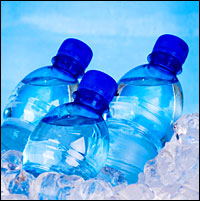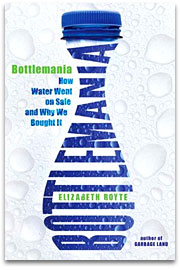 Elizabeth Royte.Photo: Rod MorrisonJournalist Elizabeth Royte drinks tap water, but she spends a lot of time thinking about the bottled kind. In her new book, Bottlemania: How Water Went on Sale and Why We Bought It, Royte investigates the causes and consequences of the bottled-water industry’s astounding growth.
Elizabeth Royte.Photo: Rod MorrisonJournalist Elizabeth Royte drinks tap water, but she spends a lot of time thinking about the bottled kind. In her new book, Bottlemania: How Water Went on Sale and Why We Bought It, Royte investigates the causes and consequences of the bottled-water industry’s astounding growth.
With her refillable water bottle in hand, Royte travels to Fryeburg, Maine, where a water-pumping operation for Nestle’s Poland Spring label divides the town. In the course of her research, she also tastes fancy bottled waters with a water connoisseur, monitors her eight-year-old daughter’s water intake, and conducts an informal poll of friends and acquaintances, asking whether they know where their tap water comes from. “Most people, even those who knew exactly how many miles the arugula on their plate had traveled, had no idea,” she writes. Royte’s own tap water comes from the famously high-quality New York City system — a network of reservoirs that, with the blessing of the U.S. EPA, makes up the largest unfiltered water supply in the nation.
Grist recently caught up with Royte to talk about hydration myths, anti-bottle mayors, and water snobbery.
 Twenty years ago, you write, bottled water was a niche market in the U.S. Today, it’s a more than $10 billion business. What the heck happened? Why did Americans start drinking so much bottled water?
Twenty years ago, you write, bottled water was a niche market in the U.S. Today, it’s a more than $10 billion business. What the heck happened? Why did Americans start drinking so much bottled water?
The simplest reason is marketing. Hundreds of millions of dollars were spent on advertising that either told us explicitly or implied that bottled water was better. [Bottled-water companies] used words like pure and natural, and used images of athletes and models and celebrities — the advertisements were aspirational, they told us we’d be more like these people if we drank this product.
While this marketing juggernaut was going on, there was also, until quite recently, a total absence of criticism. There was no competition from tap water, because utilities don’t have their own marketing budgets or ad budgets to tell us, “Tap water is great! Drink more tap water, and you’ll be thin, and look more beautiful, and do better yoga poses.”
Some of the ads criticized the quality of tap water.
Yes, they’d let us know that this was the same water used to flush toilets.
But I have to say that there are places where bottled water makes sense to many people. It doesn’t help that there are hundreds of thousands of [municipal] water-main breaks a year [in the United States], and whenever a water main breaks you get a boil-water alert. In today’s day and age, “boil water” means “buy water.”
 Do we really need as much water as the ads claim — should we conscientiously be drinking eight eight-ounce glasses every day?
Do we really need as much water as the ads claim — should we conscientiously be drinking eight eight-ounce glasses every day?
That was another part of the marketing. It was very clever of advertisers to tell us to drink more water — Pepsi actually spent $20 million on an award-winning campaign for Aquafina that just said, “Drink more water.” No one has found the definitive source [for the eight-glasses advice]. Some people point to a report from the National Research Council in the 1940s that said that the average adult needs to drink what works out to 64 ounces of water a day — but in the next sentence, it said that most of that water can come through the foods that we eat. Fruits and vegetables contain a lot of water, and I was told recently by [nutritionist] Marion Nestle that meat contains 40 percent water. Pasta and rice are two-thirds or more water by weight. But the bottled-water campaigns just told us to drink more water, and that’s why portability became so important. If you’re going to drink all that water, having it in a nice, neat plastic bottle is crucial.
You spent a lot of time in the small town of Fryeburg, Maine, where Nestle gets much of the water for its Poland Spring label. The company’s presence is hugely controversial there — what’s the crux of the disagreement?
First of all, the company came in, and in backroom, quiet deals, decided to buy water from a middleman, who was actually the son of the [local] water company’s principal owner. People didn’t know water was being pumped, and they didn’t know it was being sold to Poland Springs. Once they started paying attention to the trucks and counting them, they got worried about what was happening to the Wards Brook aquifer.
So there was some environmental concern, and then there was economic concern, people saying, “Hey, they’re taking our water and they’re selling it for a lot of money — where’s the benefit to the town? We’re dealing with all these trucks.” Then, when Nestle wanted to take water from an adjacent town called Denmark, and pump it through a pipeline to a tanker station on the state highway which happens to be in Fryeburg, the people who lived near the proposed station were horrified to learn that their quiet rural neighborhood would have 50 trucks in and 50 trucks out a day.
So you had some people concerned about the aquifer, some concerned about money, some concerned about trucks, and some people just concerned with principle of the thing, whether water is something to be commodifed, put into plastic bottles and moved around the country.
There’s been a backlash against bottled water, not only in small towns affected by the business, but among consumers in general. What’s behind the turnaround?
I think what’s behind it is the global-warming movement — a few pressure groups have been very successful at educating people about the bottled-water carbon footprint, and how much oil it takes to make, transport, and collect the bottles. They’ve had a lot of success with various mayors, first Gavin Newsom in San Francisco and then Rocky Anderson in Salt Lake City. [Last month], at the U.S. Conference of Mayors, there was a resolution passed to stop the spending of taxpayer money on bottled water at town hall and city council meetings.
For the mayors, I think it gave them eco-cred to say, “Well, you’re right, we’re spending millions of dollars on public water supplies, and we’re also spending hundreds of thousands of dollars a year for bottled water for our employees, and that doesn’t make sense.” They were also spending a lot of money collecting empty bottles, picking up litter.
These groups also go to college campuses and do blind taste tests — they’re trying to show people that in most cases, you can’t tell the difference between bottled water and tap water. It’s worked — many campuses are removing bottled water from vending machines and improving or putting in more public water fountains.
You also mention that there’s a little snobbery going on here — that there was no backlash when it was this exclusive product that only a few people drank.
Yeah, as it became more popular and everyone could buy bottled water — Dasani and Aquafina and the Nestle brands were the affordable ones — it diluted the exclusivity of it.
But I don’t think the backlash is based on this snobbery, I think the backlash is because of rising awareness — people want to appear to care about the environment. I say in the book that it’s the same people who latched on to bottled water in first place. People who were looking inward, thinking about their health, doing yoga, exercising more, were drinking what they thought was better water. Now, instead of looking inward, they’re looking outward and saying, “Wow, let’s take care of the planet.” The bottle has become the mark of the devil, the equivalent of driving a Hummer.
Where do you see the bottled water business going in the future? Who’s going to be drinking the stuff, and why?
While I see the backlash growing, I also see bottled water sales going up — the rate of growth has slowed, but there is still growth. I think that some people are so afraid of their water, for good reasons or bad, that they’re going to stick with bottled water. I think that in the developing world, as people become wealthier, they’re going to go through the same steps that we went through in [the United States]. It would be great if they would leapfrog to the backlash stage, but bottled-water sales are growing enormously in China and India.
If we continue to ignore our municipal water supplies, and we don’t fix our infrastructure, more people will have to turn to bottled water. That’s the tragedy of it, it’s a self-fulfilling prophecy. If we don’t fight for our public water supplies — for watershed protection, more money for advanced treatment technology, stopping polluters — the more we’re going to have to drink bottled water, and then we’ll have this horrible two-tiered system where only those who can afford to drink good water will have access to it — in bottles.

